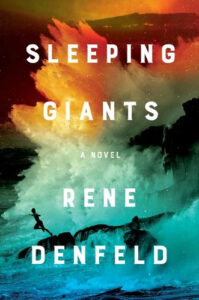In my new novel SLEEPING GIANTS, the director of a children’s home uses a draconian new treatment method. Despite being without any scientific backing, this treatment has been heralded as the latest cure for troubled children. It’s cruel, invasive, and dangerous, and has already been implicated in the deaths of several children.
Like so many who commit harm, the director is convinced she is doing the right thing. She thinks she is helping, not hindering. She believes she is on the right side. Even as her harm becomes obvious, she refuses to admit she is wrong. Instead, she doubles down, and commits even more violence to protect herself.
It’s an issue that haunts me, as I know it does many others. Why is so much harm committed by those who think they are right?
Slavery. The holocaust. Mass incarceration. The internment of Japanese Americans. Wars. Torture. Abu Ghraib. Lobotomies. Genocides. The list is endless, and I’m sure you could add many more. There’s an argument to be made that the worst harms of mankind come not at the hands of those who are social outliers at the time, but perfectly normal citizens, convinced they are doing the right thing.
I see it all the time in my justice work. For decades I’ve worked as a licensed defense investigator. I’ve worked hundreds of cases, from juvenile to death row exonerations. Far too often I’ve looked at a child facing prison time, or a man wasting his life behind bars, and I’ve wondered, who is the bad guy here? Daily I wrestle with the brutality of a nation that blithely destroys lives, all in the name of justice.
This everyday evil, I think, is underexplored territory for crime writers.
Most crime fiction focuses on the outliers—the outright, obvious sociopaths, usually unexplainably brilliant—or else criminal underworlds, like gangs or drug cartels. This is all interesting stuff. But I think it has the effect of othering violence. It assumes there is a world full of normal people who are blameless, who couldn’t fathom the idea of committing harm even if you suggested it. This creates a false dichotomy, an us vs them that is troubling and honestly, kind of disingenuous.
It’s true, most people don’t go around committing egregious crimes. Not directly, at least. But spend a few hours on a next-door neighbor site and you can see the seething anger that boils into outright discrimination, the rage that leads people to the voter’s ballot to pass even more punitive laws, and elect officials who will do their dirty work for them.
These regular, everyday citizens might not be the ones administering the lethal dose, or locking people up, or torturing children, but they are the mass behind the monsters. Collectively, they can become the monster.
This is not confined to politics or borders. Some of the most vicious people I’ve ever met have been the self-proclaimed enlightened. It’s the motive under the act that intrigues me, not the placard above it.
In Sleeping Giants, I wanted to dig into those motives.
In the novel, sleeping giants are massive stone age carvings found in Arizona. But the real sleeping giants are the secret, hidden pains, and anger inside us that can come out in misdirected rage. In my experience, when these sleeping giants are awakened with a cause—especially one driven by white supremacy, misogyny, or other biases— a permission slip to commit harm is signed, sealed, and delivered.
For the director, the treatment method appeals to her own unexamined hurts and anger. It’s a chance to hurt others as she was once hurt. I think this is behind a lot of societal harm, only we poo-poo it. For some weird reason, we separate our acts from our feelings, as if we operate from some higher, clinical self when making decisions.
Nothing could be further from the truth. As my friend and playwright Claire Willett once said, “honestly the best marketing scheme in history is men successfully getting away with calling women the more emotional gender for like, EONS, because they’ve successfully rebranded anger as Not an Emotion.” I would add that cloaking rage as reason is the defense of most offenders.
Just as there was never any science behind torture, or conversion therapy, or the other atrocities I mentioned, there is no good reason behind most the harm we commit. We may go looking for excuses after the fact—inventing science, inventing reasons—but these are not the true motivations. Those are just the rules we invent to give legitimacy to our cause.
When we believe others are harmful, then it becomes easier to put them in cages, and arm ourselves against their release. We write books where we exorcise all our fears and hates into an effigy called the bad guy, and we burn him at the stake. But what will we do when we turn around and see everyone watching is the bad guy? This is the dilemma we must face in fiction and in life.
Initially, I worried this story would lack in tension. There is the director, and a little boy in the center named Dennis, who becomes the target of her rage. Twenty years after Dennis goes missing, his sister learns of his existence and goes looking for him. In the process she uncovers decades of crimes. Without the artifice of a conventional bad guy, could I keep the reader turning the pages?
Once we abandon the idea that crime is committed by the other, we open ourselves up to more realistic characters…What I found is there is more than enough tension in real life scenarios. In fact, I think they are scarier, because what happens in Sleeping Giants is real. The bad guy is a smiling, nice-looking lady that people trust. She could be your neighbor. She could be any of us. She doesn’t even think she is bad.
Once we abandon the idea that crime is committed by the other, we open ourselves up to more realistic characters, and this includes the heroes, too. In Sleeping Giants, the hero is not some hard-boiled detective, but the sister. This young woman, Amanda, has some learning differences. To my knowledge, she’s the first hero with these particular differences, but they are not the center of her story. The center is her longing for truth, and knowledge. That’s enough to get her in a lot of trouble, as many women know.
In her efforts to find the truth, Amanda is abetted by a cop, but once again, he’s an ordinary person. Larry Palmer is recently widowed, and grieving. He’s bored and lonely in his small coastal town, where the center was located. Larry has committed harm in the name of good, too. Everyone in this story is in a path of reckoning.
There’s been a lot of discourse lately about “unlikable” women characters and unreliable narrators. I think the hunger under these conversations is for books that deal with the fact that good people can do bad things. Sometimes very, very bad things. Or they might stand around and applaud when others do the bad things, and when justice finally comes to call, claim they weren’t there at all. In other words, we want real people on the page.
None of this is to shame anyone. We’re all capable of harm, whether against others, ourselves, or other critters sharing our planet. In fact, there are animals in Sleeping Giants, and I wanted to thread their realities into the novel. There is a rabbit that Dennis likes to watch at the center, and a polar bear that Amanda cares for at the zoo. Both have their stories, too.
In my own work, I’ve found the more divorced people are from their internal selves, the more separate they are from the outside world. It’s an interesting pattern, and one reason I believe that connecting with nature is so important. It doesn’t have to be fancy or expensive. Just being outside, and feeling part of the world, can help people believe their feelings matter, too. As long as people devalue their own sleeping giants, they will overinflate their rage, and become convinced that is who they are. Which is sad, considering how soft and tender we really are, inside.
At the end of Sleeping Giants, the director finally has her reckoning, and it is not the punishment some might hope. I’ve noticed that even behind bars, most guilty people don’t admit their wrongs, just as they don’t admit them outside of prison, either. It’s on the rest of us to fix their mistakes. And try to prevent more. Because just as we are capable of everyday evil in the name of good, we are also capable of profound healing, joy, and goodness.
That is the final, hopeful message of the book. By facing down our inner hurts and angers, we can heal ourselves and make better decisions. The sleeping giant, once awakened, turns out to be not so bad after all.
***


















